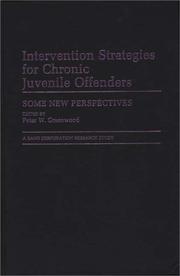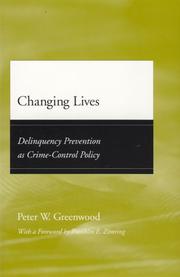| Listing 1 - 10 of 17 | << page >> |
Sort by
|

ISBN: 0313255768 9780313255762 Year: 1986 Volume: 15 Publisher: New York (N.Y.): Greenwood,
Abstract | Keywords | Export | Availability | Bookmark
 Loading...
Loading...Choose an application
- Reference Manager
- EndNote
- RefWorks (Direct export to RefWorks)
Juvenile delinquents --- Juvenile justice, Administration of --- Juvenile delinquency --- Juvenile recidivists --- Rehabilitation --- Prevention --- 343.88 --- 343.85 --- -Juvenile delinquents --- -Juvenile justice, Administration of --- Chronic juvenile delinquents --- Chronic juvenile offenders --- Habitual juvenile delinquents --- Habitual juvenile offenders --- Incorrigibles (Juvenile delinquency) --- Repeat juvenile delinquents --- Repeat juvenile offenders --- Recidivists --- Administration of juvenile justice --- Criminal justice, Administration of --- Delinquents --- Delinquents, Juvenile --- Juvenile offenders --- Offenders, Juvenile --- Offenders, Youthful --- Young offenders --- Youthful offenders --- Criminals --- Youth --- Delinquency, Juvenile --- Juvenile crime --- Conduct disorders in children --- Crime --- Juvenile corrections --- Reformatories --- Jeugdbescherming --- Criminele profylaxie. Voorkomen van de misdaad. Strijd tegen de misdaad. Preventieve gevangenisstraf. Eugenese. Sterilisatie --- Law and legislation --- 343.85 Criminele profylaxie. Voorkomen van de misdaad. Strijd tegen de misdaad. Preventieve gevangenisstraf. Eugenese. Sterilisatie --- 343.88 Jeugdbescherming --- Rehabilitation of juvenile delinquents --- Prevention of juvenile delinquency --- Crime prevention --- Juvenile delinquents - Rehabilitation --- Juvenile delinquency - Prevention
Book
Year: 1994 Publisher: Santa Monica, CA : RAND Corporation,
Abstract | Keywords | Export | Availability | Bookmark
 Loading...
Loading...Choose an application
- Reference Manager
- EndNote
- RefWorks (Direct export to RefWorks)
The authors report on the benefits and costs of California's new mandatory-sentencing law, which provides for progressively longer sentences with an increasing number of prior convictions for serious felonies. The authors find that the new law, if fully implemented, will decrease serious crime committed by adults by about 28 percent at a cost of an extra $5.5 billion a year. Alternatives that narrow the law's application result in a lower benefit but an even greater reduction in costs. The authors were also able to devise an alternative that resulted in the same crime-reduction benefit for lower cost. The authors conclude that the state budget cuts required to fund the new law will be so great that it is unlikely to be fully implemented
Prison sentences --- Mandatory sentences --- Imprisonment --- Costs. --- Government policy --- Economic aspects --- Jones 3-Strikes Law.

ISBN: 1281956988 9786611956981 0226307239 9780226307237 9781281956989 6611956980 9780226307190 0226307190 9780226307206 0226307204 Year: 2006 Publisher: Chicago University of Chicago Press
Abstract | Keywords | Export | Availability | Bookmark
 Loading...
Loading...Choose an application
- Reference Manager
- EndNote
- RefWorks (Direct export to RefWorks)
One of the most astonishing aspects of juvenile crime is how little is known about the impact of the policies and programs put in place to fight it. The most commonly used strategies and programs for combating juvenile delinquency problems primarily rely on intuition and fads. Fortunately, as a result of the promising new research documented in Changing Lives, these deficiencies in our juvenile justice system might quickly be remedied. Peter W. Greenwood here demonstrates here that as crimes rates have fallen, researchers have identified more connections between specific risk factors and criminal behavior, while program developers have discovered a wide array of innovative interventions. The result of all this activity, he reveals, has been the revelation of a few prevention models that reduce crime much more cost-effectively than popular approaches such as tougher sentencing, D.A.R.E., boot camps, and "scared straight" programs. Changing Lives expertly presents the most promising of these prevention programs, their histories, the quality of evidence to support their effectiveness, the public policy programs involved in bringing them into wider use, and the potential for investments and developmental research to increase the range and quality of programs.
Juvenile delinquency --- Juvenile delinquents --- Crime prevention --- Prevention. --- Rehabilitation --- criminal, crimes, police, social studies, academic, scholarly, research, youth, young, juvenile, teen, high school, justice, policy, programming, programs, policies, juvie, risk, behavior, psychology, prevention, dare, boot camp, scared straight, schools, educational, public, america, united states, efficacy, government, political, politics. --- Prevention

ISBN: 0226307190 9780226307206 Year: 2006 Publisher: Chicago University of Chicago Press
Abstract | Keywords | Export | Availability | Bookmark
 Loading...
Loading...Choose an application
- Reference Manager
- EndNote
- RefWorks (Direct export to RefWorks)
One of the most astonishing aspects of juvenile crime is how little is known about the impact of the policies and programs put in place to fight it. The most commonly used strategies and programs for combating juvenile delinquency problems primarily rely on intuition and fads. Fortunately, as a result of the promising new research documented in 'Changing Lives,' these deficiencies in our juvenile justice system might quickly be remedied. Peter W. Greenwood here demonstrates here that as crimes rates have fallen, researchers have identified more connections between specific risk factors and criminal behavior, while program developers have discovered a wide array of innovative interventions. The result of all this activity, he reveals, has been the revelation of a few prevention models that reduce crime much more cost-effectively than popular approaches such as tougher sentencing, D.A.R.E., boot camps, and "scared straight" programs. 'Changing Lives 'expertly presents the most promising of these prevention programs, their histories, the quality of evidence to support their effectiveness, the public policy programs involved in bringing them into wider use, and the potential for investments and developmental research to increase the range and quality of programs.
Crime prevention --- Juvenile delinquency --- Juvenile delinquents --- Prevention. --- Rehabilitation --- Prevention

ISBN: 9780833004338 0833004336 Year: 1982 Publisher: Santa Monica: Rand corporation,
Abstract | Keywords | Export | Availability | Bookmark
 Loading...
Loading...Choose an application
- Reference Manager
- EndNote
- RefWorks (Direct export to RefWorks)
Book
Year: 1978 Publisher: [Washington] : National Institute of Law Enforcement and Criminal Justice, Law Enforcement Assistance Administration,
Abstract | Keywords | Export | Availability | Bookmark
 Loading...
Loading...Choose an application
- Reference Manager
- EndNote
- RefWorks (Direct export to RefWorks)
Recidivists --- Criminals --- Criminal justice, Administration of
Book
Year: 1977 Publisher: Washington (D.C.): Department of justice. National institute of justice
Abstract | Keywords | Export | Availability | Bookmark
 Loading...
Loading...Choose an application
- Reference Manager
- EndNote
- RefWorks (Direct export to RefWorks)
Book
Abstract | Keywords | Export | Availability | Bookmark
 Loading...
Loading...Choose an application
- Reference Manager
- EndNote
- RefWorks (Direct export to RefWorks)
Book
Year: 1994 Publisher: Santa Monica, CA : RAND Corporation,
Abstract | Keywords | Export | Availability | Bookmark
 Loading...
Loading...Choose an application
- Reference Manager
- EndNote
- RefWorks (Direct export to RefWorks)
A classical experimental design was used to determine whether delinquents assigned to an experimental intensive aftercare program implemented in two sites had lower relapse and recidivism rates and a better readjustment to the community than control youths assigned to regular supervision following residential placement, provided by social workers or probation officers. Interviews with youths and staff suggest that the experimental program was more intensive in terms of the frequency of contact and counseling. Twelve month follow-up data showed a decline in coping skills, personal goals, and self-efficacy, and no significant differences in arrests, self-reported delinquency or substance use.
Juvenile delinquents --- Social work with juvenile delinquents --- Juvenile recidivists --- Rehabilitation
Book
Year: 1970 Publisher: New York (N.Y.): Rand
Abstract | Keywords | Export | Availability | Bookmark
 Loading...
Loading...Choose an application
- Reference Manager
- EndNote
- RefWorks (Direct export to RefWorks)
| Listing 1 - 10 of 17 | << page >> |
Sort by
|

 Search
Search Feedback
Feedback About UniCat
About UniCat  Help
Help News
News